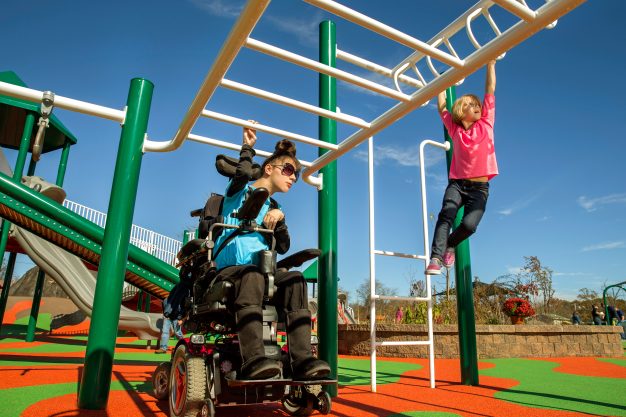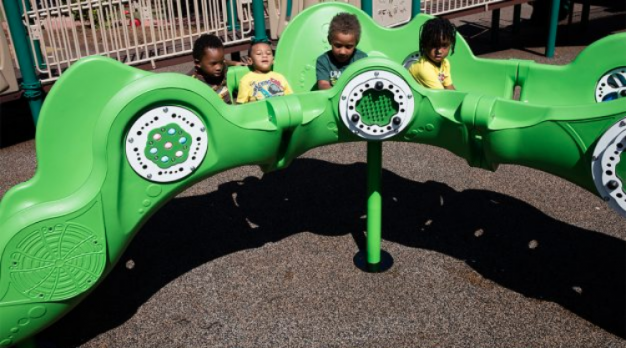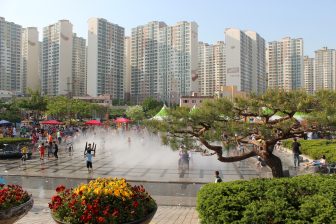
Building inclusive play spaces
Anne-Marie Spencer argues building inclusive play spaces is possible when we consider the whole child, whole environment, and whole community.
Inclusive play. Ask 10 people what it means and it’s quite possible you’ll get 10 different answers. Adhering to ADA Standards for Accessible Design. Creating access on the playground. Including products for children with disabilities. Ensuring individuals who use mobility devices can use the playground, and so on. The truth is that it means all of these things, and a great deal more.
What is inclusive play?
Simply put, an inclusive play space breaks down barriers to physical access and social participation. It ensures the greatest use of the whole environment, to the greatest extent possible, by creating equitable play experiences on the playground that children of all abilities can use. The term all abilities certainly includes those who use wheelchairs, but inclusion doesn’t stop there. True inclusion considers all people, across a broad spectrum of abilities, age, and skill. And while there may be a wealth of opinion on what makes a playground inclusive, inclusion isn’t a subject that can be predicated on opinion. Inclusive play spaces are so critical that their design and creation should be founded on scholarly, evidence-based research.
According to the research in Me2: The 7 Principles of Inclusive Playground Design®, Utah State’s Center for Persons with Disabilities states that disability is a natural part of the human experience that in no way diminishes a child’s right to fully participate in all aspects of childhood, including play. While disability is often mistaken as a child’s inability to experience the play environment due to limitations caused by their disability, the disability isn’t what is standing in the way. The fault actually lies within the environments that have not been properly designed to provide recreation to a wider context of users. To ensure inclusive design, the right team needs to be included in the planning, and creativity and innovation are needed throughout the process.
Most importantly, however, expertise is compulsory to ensure that the direction, design, and execution result in the desired outcomes. Successful groups who are working to achieve greater diversity and increase inclusion understand that evidence-based, credible, scholarly research is required to identify barriers, create evidence-based recommendations, promote intentional approaches to design, measure outcomes, and provide clear measurable guidelines to promote equal opportunities. Implementation of these steps helps ensure the resulting space benefits the whole child, whole environment and whole community.
An inclusive play environment
There have been a lot of opinions lately on what constitutes an inclusive play product within an inclusive play environment. While there may be products that are not accessible in a play space, a truly inclusive environment will include an equitable experience, in close proximity, so that children who may not be comfortable using one product have another one nearby that offers a similar experience in a way they can participate. Take climbing nets for example, while a child who has use of their legs may climb, recent claims that a child in a mobility device gets an experience equitable to climbing by “holding the net and feeling the vibrations,” is simply incorrect.
Climbing is a different experience than feeling the vibrations. The former involves vestibular/proprioceptive stimuli, the latter is a tactile stimulus. In this specific context, one type of stimuli is more desirable, or ‘fun’, than the other. If the two experiences were equal in their desirability you would see children without disabilities holding the net to feel it vibrate, which you don’t. An inclusive environment is designed to support equality of play opportunity to the greatest extent possible in each context, so the context is the primary purpose of the play setting.
If equipment is designed for climbing, the stimuli supported is vestibular/proprioceptive, so the equitable play affordance would offer the same stimuli. Therefore, an equitable experience to the climbing net may involve a climber that features transfer points, handholds, and the ability for all to reach the highest level of the apparatus. Another example to integrate equitable climbing alternatives may be including high and low monkey bars alongside therapeutic rings, providing three ways to utilize upper body strength.

Age-focused play design
It’s probably not reasonable to think that every piece of equipment at a playground is going to be usable to the same extent by everyone who comes to play. We can compare this to the familiar concept of safety considerations observed in age-focused play design, in either example, it’s a matter of applying different parameters to the choices to ensure that all can experience the environment in a way they find comfortable and equitable. A young child, or one new to the experience may be more comfortable on a 4’ slide, while an older, or more experienced slider may gravitate to an 8’ slide. Same experience, scaled for each user. A child with the ability to support their body may select a traditional strap seat swing, while a child with limited body control can enjoy the additional support of a chair seat swing. Same experience, scaled for the user.
It’s also important to note that an inclusive play space considers much more than access and wheelchair use. For while 85 of 1000 children between the ages of 3 and 21 will have a disability, one will be physical, and the other 84 will encompass communication, cognitive, social/emotional, and other types of disability. Their enjoyment of the environment, and providing equitable experiences to align to this joy, is key to an inclusive space. Playgrounds can be special places where the needs of all children, including those with and without disabilities can be secured by intentionally providing opportunities that embrace the five domains of child development, physical, socio-emotional, sensory, cognitive, and communicative.
Creating a play space for all involves supporting physical development, supporting interactions with peers to develop social learning, problem-solving, social exchanges, cooperative behavior, and the empathy associated with social and emotional development. Positive sensory development requires children with disabilities be able to regulate their sensory input within an environment. Communicative development occurs when children with disabilities are able to independently model social interactions and effectively communicate with their peers.
An inclusive community
Researchers, educators, and early childhood professionals have emphasized the interrelation and interdependence of these developmental domains and processes, which are linked with social and mental health, culture, relationship development, and brain function. Designing environments that consider these domains and processes will encompass both the individual play activities as well as the context of the overall environmental design. Rallying around the health and well-being of children in a meaningful way is a community effort.
When the community recognizes the diverse needs of children and families, and seeks to build solutions through inclusive play spaces, they make a fundamental statement about their community’s values and beliefs. Inclusive play offers many benefits that positively impact community outcomes, support diversity, encourage fun, and build community capital and social equity. By utilizing the process as an opportunity to join like-minded stakeholders, an effective strategy can be undertaken that ensures engagement and a lasting legacy for years to come. Thinking strategically about how your inclusive play space can be programmed can also greatly increase usage of the space.
Contact among children with different abilities is often not enough to get children independently playing together, so social intervention strategies can be implemented by educators and programmers to help children understand how to successfully play together, equip them with the tools to ask questions, get accurate information, explore their feelings and learn how to positively interact with their peers. The inclusive activities found in the guidebook 2 Play Together, Playground Activities to Foster Friendships Through Inclusive Play®, incorporate considerations for interactive play based on observations of how children initiate interaction then apply strategies that foster social inclusion. Teaching children how they can play together takes inclusion to the next level and can be critical for meaningful play experiences.
Conclusion
Through thoughtful design, execution, and programming, every play environment can offer more meaningful inclusive play experiences for the diverse needs of members of the community. Whole communities start with inclusive whole environments that have carefully met the needs of the whole child. Whether it is a large destination or a small urban pocket park, every play and recreation setting can uniquely tell the story of a community’s dedication to providing the critical benefits of play.
Understanding the value of inclusive play helps communities advocate and invest in the diverse needs of society, resulting in positive community outcomes. By mobilizing resource, educating ourselves on evidence-based, credible inclusive play research, and then aligning efforts, we can raise awareness, break down barriers, foster friendships, and unite communities across the world with amazing results. Together we can put research into action and help advocate for inclusive, multigenerational play destinations that benefit the Whole Child, Whole Environment and Whole Communities™.
Courtesy of Playground Professionals (PGP)




Where can we find and discuss inclusive play research? We have created an institution in Brazil which creates and donates parks where children with disabilities can play safely with children without disabilities, but I do not find many similar initiatives in developed countries.
Thank you for your contribution Rodolfo Henrique Fischer. At Child in the City we are hoping to encourage our readers to share and discuss their research. We would be interested in hearing more about your work. I will email you with more information.